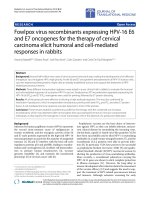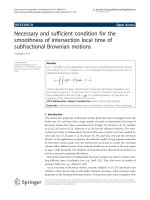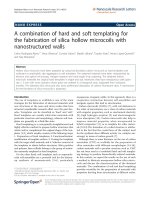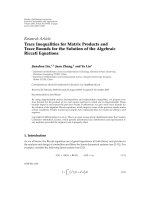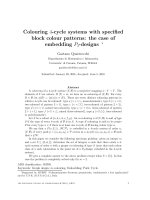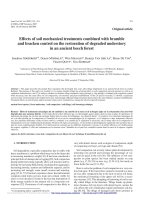Multicomponent systems with cyclodextrins and hydrophilic polymers for the delivery of Efavirenz
Bạn đang xem bản rút gọn của tài liệu. Xem và tải ngay bản đầy đủ của tài liệu tại đây (1.75 MB, 8 trang )
Carbohydrate Polymers 130 (2015) 133–140
Contents lists available at ScienceDirect
Carbohydrate Polymers
journal homepage: www.elsevier.com/locate/carbpol
Multicomponent systems with cyclodextrins and hydrophilic
polymers for the delivery of Efavirenz
Alexandre Couto Carneiro Vieira a,1 , Danilo Augusto Ferreira Fontes a ,
Luise Lopes Chaves a,1 , Lariza Darlene Santos Alves a , José Lourenc¸o de Freitas Neto a ,
Monica Felts de La Roca Soares c , Jose L. Soares-Sobrinho c,∗ , Larissa Arẳjo Rolim a,b ,
Pedro José Rolim-Neto a
a
Laboratório de Tecnologia Farmacêutica da Universidade Federal de Pernambuco, Rua Arthur de Sá, s/n, Cidade Universitária, 50, 740-521 Recife, PE, Brazil
Colegiado de Ciências Farmacêuticas da Universidade Federal do Vale do São Francisco (UNIVASF) Campus Petrolina I, Petrolina, PE, Brazil
c
Núcleo de Controle de Qualidade de Medicamentos e Correlatos – NCQMC da Universidade Federal de Pernambuco, Rua Arthur de Sá, s/n,
Cidade Universitária, 50, 740-521 Recife, PE, Brazil
b
a r t i c l e
i n f o
Article history:
Received 30 March 2015
Received in revised form 21 April 2015
Accepted 23 April 2015
Available online 1 May 2015
Keywords:
Low solubility
Polymers
Ternary systems
Inclusion complex
Delivery systems
a b s t r a c t
Efavirenz (EFZ) is one of the most used drugs in the treatment of AIDS and is the first antiretroviral choice.
However, since it has low solubility, it does not exhibit suitable bioavailability, which interferes with its
therapeutic action and is classified as a class II drug according Biopharmaceutical Classification System
(low solubility and high permeability). Among several drug delivery systems, the multicomponent systems with cyclodextrins and hydrophilic polymers are a promising alternative for increasing the aqueous
solubility of the drug. The present study aimed to develop and characterize in a ternary system of EFZ,
MCD and PVP K30. The results showed that the solid ternary system provided a large increase in the
dissolution rate which was greater than 80% and was characterized by DSC, TG, XRD, FT-IR and SEM. The
use of the ternary system (EFZ, MCD and PVP K30 1%) proved to be a viable, effective and safe delivery
of the drug. The addition of the hydrophilic polymer appeared to be suitable for the development of a
solid oral pharmaceutical product, with possible industrial scale-up and with low concentration of CDs
(cyclodextrins).
© 2015 Elsevier Ltd. All rights reserved.
1. Introduction
Oral ingestion is the most convenient and commonly employed
route of drug delivery due to its easy administration, high patient
compliance, cost-effectiveness, least sterility constraints, and flexibility in the design of the dosage form (Savjani, Gajjar, & Savjani,
2012).
However, the major challenge during the design of oral dosage
forms lies in their poor bioavailability (Chaves, Vieira, Reis,
Sarmento, & Ferriera, 2014). The oral bioavailability depends on
several factors including aqueous solubility, drug permeability, dissolution rate, first-pass metabolism, pre-systemic metabolism, and
∗ Corresponding author.
E-mail address: (J.L. Soares-Sobrinho).
1
Address: UCIBIO, REQUIMTE, Laboratory of Applied Chemistry, Department of
Chemical Sciences, Faculty of Pharmacy, University of Porto, Rua de Jorge Viterbo
de Ferreira, 228, Porto 4050-313, Portugal.
/>0144-8617/© 2015 Elsevier Ltd. All rights reserved.
susceptibility to efflux mechanisms. However, the major issue that
leads to low oral bioavailability is poor solubility and low permeability (Chouhan & Saini, 2014; Gundogdu, Koksal, & Karasulu,
2012; Savjani et al., 2012).
Low aqueous solubility is the major problem encountered with
the formulation development of new chemical entities (Chaves
et al., 2014). More than 40% of new chemical entities developed
in the pharmaceutical industry are practically insoluble in water.
Poorly water-soluble drugs present slow drug absorption, and
lead to inadequate and variable bioavailability and gastrointestinal
mucosal toxicity (Kumar et al., 2011; Miletic, Kyriakos, Graovac, &
Ibric, 2013; Sharma, Soni, Kumar, & Gupta, 2009). This is a challenge especially for class II (low solubility and high permeability)
substances according to the BCS. In these cases, the bioavailability
may be enhanced by increasing the solubility and dissolution rate
of the drug in the gastrointestinal fluids (Krishnaiah, 2010; Kumar
et al., 2011; Rong et al., 2014; Savjani et al., 2012).
Among all solubility enhancement techniques, the generation
of inclusion complexes with cyclodextrins has been employed
more precisely to improve the aqueous solubility, dissolution rate,
134
A.C.C. Vieira et al. / Carbohydrate Polymers 130 (2015) 133–140
and bioavailability of poorly water-soluble drugs (Pose-Vilarnovo,
Rodríguez-Tenreiro Sánchez, Diéguez Moure, Vila-Jato, & TorresLabandeira, 2003; Rong et al., 2014).
Cyclodextrins (CDs) are naturally available water-soluble cyclic
oligosaccharides composed of ␣-1,4-linked d-glucopyranose units
(Ribeiro, Carvalho, Ferreira, & Veiga, 2005) arranged in a donutshaped ring having a hydrophobic cavity and hydrophilic outer
surface (Savjani et al., 2012). This low polarity central cavity is able
to encapsulate, either partially or entirely, a great variety of guest
molecules of suitable size and shape resulting in a stable association without formation of covalent bonds, resulting in an entity
known as a host–guest complex or inclusion complex (Miletic et al.,
2013; Mora et al., 2003; Ribeiro et al., 2005; Saenger, 1980; SoaresSobrinho et al., 2012), Unfortunately, the complexation efficiency
of cyclodextrins is rather low and, therefore, a significant amount
of cyclodextrins is needed to solubilize a small amount of waterinsoluble compounds. However, enhanced complexation can be
achieved by formation of ternary complexes (or co-complexes)
between the drug molecule, cyclodextrin molecule and a third component. Moreover, recent works have shown that the addition of a
suitable third component can often significantly improve both the
solubilizing and complexing abilities of cyclodextrins with several
´
´
´
c-La
can,
2004; Mora et al., 2003).
drugs (Jug & Becirevi
For several reasons, including toxicology, dosage and cost, the
amount of cyclodextrins used in most of the formulations must
be limited. Therefore, it is important to develop strategies to
increase the effectiveness of cyclodextrin complexation that could
be reflected in a reduction in the amount of CD necessary in a particular drug formulation (Pose-Vilarnovo et al., 2003; Soares-Sobrinho
et al., 2012). To this end the use of water-soluble polymers, the
preparation of drug/CD/polymers (Du et al., 2012; Feng, Lu, Li,
& Huang, 2013; Loftsson, Frikdriksdóttir, Sigurkdardóttir, & Ueda,
1994; Taupitz, Dressman, Buchanan, & Klein, 2013; Valero, PérezRevuelta, & Rodrı´ıguez, 2003), multicomponent systems, or the
formation of CD complexes of salts of acidic drugs have been
described. The use of polymers has been used, at great expense,
in recent years but the exact nature of the polymer CD interaction
is not known yet (Pose-Vilarnovo et al., 2003; Redenti, Szente, &
Szejtli, 2001; Valero et al., 2003).
Despite being widely used in therapeutics, Efavirenz (EFZ) has
very low oral bioavailability (40–45%) (Sathigari, Radhakrishnan,
Davis, Parsons, & Babu, 2012). EFZ is crystalline, highly lipophilic
and has been classified in the Biopharmaceutics Classification System as a class II compound with high permeability but low aqueous
solubility (∼3–9 g/mL) with dissolution, rate-dependent absorption (Chiappetta, Hocht, Taira, & Sosnik, 2011; Lindenberg, Kopp, &
Dressman, 2004; Madhavi et al., 2011; Sathigari et al., 2012).
Different techniques have been used to enhance the solubility and dissolution rate of poorly soluble drugs in water such as
micronization, polymorphs, solid dispersions, complexation with
cyclodextrins, polymeric and lipid nanoparticles, and salt formation (Alves et al., 2014; Chiappetta et al., 2011; Gaur, Mishra, Bajpai,
& Mishra, 2014; Leuner & Dressman, 2000; Paudel, Worku, Meeus,
Guns, & Van den Mooter, 2013; Soares-Sobrinho et al., 2012).
Therefore, the aim of this study was to evaluate the influence of
the type of cyclodextrin on the properties of a poorly soluble model
drug, EFZ, as well as to evaluate the effect of a drug–CD–polymer
on the solubility of EFZ.
by ISO Brazil® (lot 05500138511V06/08), and sodium lauryl sulfate
(SLS) by Vetec® (lot 0806072). The solutions were prepared using
ultrapure water (MILLI Q) and filtered through a 0.22 m Millipore®
membrane (Millipore Corp, Billerica, MA). Other reagents and
chemicals were of analytical reagent grade.
2.1. Phase-solubility diagram
The phase-solubility diagrams were performed similar to those
performed by Soares-Sobrinho et al. (2012).
In order to select the best cyclodextrin, a phase-solubility diagram with different types of cyclodextrins (CDs) was constructed.
Aqueous solutions of ␣CD, MCD, HPCD and RMCD were prepared at the concentration range of between 1 and 20 mM, and
between 1 and 15 mM for CD due its low solubility (Loftsson &
Brewster, 1996). An excess amount of EFZ (∼30 mg) was added to
each test tube containing 10 mL deionized water. The test tubes
were sealed and shaken for 5 days in an oscillating water bath thermostatically controlled at 25 ± 0.5 ◦ C and, then, the content of each
test tube was filtered through a 0.22 m cellulose membrane filter.
The filtrate was suitably diluted and analyzed spectrophotometrically at 247 nm by a method previously developed and validated
(Alves et al., 2010). The experiment was performed in triplicate.
Afterwards, in order to evaluate the interactions of cyclodextrins and a hydrophilic polymer in the increasing of EFZ solubility,
another phase-solubility diagram was constructed. For this purpose, MCD was used as a model at a fixed concentration (10 mM)
in aqueous solutions while increasing concentrations (0.05–1%,
w/w) of a hydrophilic polymer (PVP K30) were used.
2.2. Preparation of inclusion complexes in a solid state
For the obtainment of the solid inclusion complexes, EFZ/MCD
(mol/mol) was used with PVP-K30 in crescent concentrations (1%,
5%, 10% and 30%).
2.2.1. Preparation of physical mixtures (PMs)
EFZ and MCD were precisely weighed in an equimolar ratio
(10 mM) and PVP-K30 was used in different weight ratios (1, 5,
10 and 30%) in relation to the total amount of the binary systems EFZ:MCD. Subsequently, the mixtures were pulverized with
a mortar and a pestle and were sifted through a 250 m mesh and
stored in airtight glass desiccators under a vacuum.
2.2.2. Preparation of the kneading (KN) complexes
The KN system was prepared similarly to the physical mixture,
supplemented by the slow addition of an ethanol/water solution
(1:1, v/v) until homogeneous (Alves et al., 2014) in order to obtain
a moist bulk, characteristic of the kneading process. The samples
were dried at 50 ◦ C for 60 min; the resulting solid inclusion complex was sifted through a 250 m sieve and then the products were
placed in vials and stored in an airtight glass desiccator under a
vacuum. The kneading process has important advantages as simple obtention, high-yielding, and easy scale up. Nowadays, it is still
the most commonly used method in the pharmaceutical industry
(Pupe et al., 2011; Soares-Sobrinho et al., 2012).
2.3. Characterization of the solid state complex
2. Materials and methods
Efavirenz (Cristália® , Batch: 1289/07) was provided by
the Laboratório Farmacêutico de Pernambuco (LAFEPE). Methyl-cyclodextrin (MCD) was provided by Roquette® (Spain),
polyvinylpyrrolidone (PVP) K-30 by BASF® , Germany; and PVP K30
2.3.1. Dissolution profile
Studies of drug release were performed in quadruplicate using
dissolution test equipment, employing the apparatus paddle at
50 rpm in a dissolution medium of water with 0.5% sodium lauryl sulfate (SLS) (900 mL) at 37 ± 0.5 ◦ C (Alves et al., 2014; Pinto,
Cabral, & Sousa, 2014).
A.C.C. Vieira et al. / Carbohydrate Polymers 130 (2015) 133–140
Capsules containing the equivalent of 30 mg of drug were used.
Aliquots of 4 mL were withdrawn at 15, 30, 45, and 60 min, and the
same volume of dissolution medium was replaced. The samples
were filtered through a 0.45 m porosity membrane and properly
quantified.
2.3.2. X-ray powder diffraction (XRD)
The diffraction patterns of samples were obtained using an X-ray
diffractometer (Siemens® , D-5000), equipped with a copper anode.
The samples were analyzed in the 2Â angle range of 2–60 at a scan
speed of 0.02◦ 2Â/s. The samples were prepared in glass holders
with a thin layer of powder material without solvent.
2.3.3. Fourier transform infrared (FT-IR)
The infrared spectrum was obtained using a device equipped
with a selenium attenuated total reflectance (ATR) crystal
(PerkinElmer® , Spectrum 400). The samples to be analyzed were
transferred directly to the ATR compartment and the result was
taken to be the average of 10 scans. The micrographs were obtained
for the range of 650–4000 cm−1 at a resolution of 4 cm−1 .
2.3.4. Differential scanning calorimetry (DSC)
DSC studies were carried out using differential scanning
calorimeter (DSC 60, Shi-madzu, Japan). The samples, with the
equivalent of 2 mg of drug (±0.2 mg), were hermetically sealed in
aluminum pans and heated at a constant rate of 10 ◦ C min−1 at a
temperature range of 25–200 ◦ C. An inert atmosphere was maintained by purging nitrogen gas at a flow rate of 50 mL min−1 .
2.3.5. Thermogravimetry (TG)
Thermoanalytical characterization using TG was performed in
triplicate by a, Shimadzu® TGA thermobalance, model Q60, in a
nitrogen atmosphere with a flow of 50 mL min−1 . The sample mass
was of about 4 mg (±0.4) of EFZ, packed in an aluminum oxide crucible at a temperature range of 25–500 ◦ C at the heating rate of
10 ◦ C min−1 .
2.3.6. Scanning electron microscopy (SEM)
The samples were sputter-coated with gold using a vacuum
evaporator (Baltec® SCD 050 metalizer) and examined using a scanning electron microscope (Jeol® JSM-5900) at 15 kV accelerating
voltage.
3. Results and discussion
3.1. Phase-solubility diagram
Phase-solubility studies of binary systems (EFZ:CDs) (Fig. 1),
were performed in order to observe the effect of the complexation
135
Table 1
Complexation constants (Kc1:1 ) for EFZ:CDs and EFZ:CDs:PVP K30 determined by
solubility phase diagram.
Systems binary and ternary
Slope
Intercept
Kc1:1 (M−1 )
EFZ:CD
EFZ:␣CD
EFZ:RMCD
EFZ:HPCD
EFZ:MCD
EFZ:HPCD:PVP K30
EFZ:MCD:PVP K30
0.00485
0.00630
0.00729
0.00956
0.01060
0.03024
0.05234
0.02613
0.02918
0.03032
0.02508
0.02884
0.14246
0.13256
184.7
214.5
238.7
377.5
363.6
218.9
416.6
ability of different types of cyclodextrin systems. In accordance
with the results, it was observed that the cyclodextrin that
increased EFZ solubility better was MCD (from 9 g/mL to
75,227 g/mL) (Loh, Tan, & Peh, 2014).
In addition, it is well established that from these diagrams it is
possible to estimate the stoichiometry involved (Jullian et al., 2008;
Xu et al., 2014). The experimental results demonstrated that the
obtainment of inclusion complexes with a typical profile and suggested an occurrence of soluble complexes with 1:1 stoichiometry
(Sathigari et al., 2009).
The complexation constants (Kc) (Jug, Kosalec, Maestrelli, &
Mura, 2011) are given in Table 1. Kc1:1 , calculated on the basis of
the solubility phase diagram, shows that the formation of inclusion complexes and ternary complexes are stable with EFZ, since,
according to Jun et al. (2007), the association constants for drugs
with CDs appear in the 50–2000 M−1 band.
Regarding the ternary complexes, the choice of PVP K30 as a
hydrophilic polymer to increase the solubility of EFZ had been
already studied (Alves et al., 2014; Soares-Sobrinho et al., 2012).
Besides, the effect of the hydrophilic polymer association with
cyclodextrins to increase the solubility of insoluble drugs is
well established in the literature (Cappello, Carmignani, Iervolino,
Immacolata La Rotonda, & Fabrizio Saettone, 2001; de Melo et al.,
2013; Soares-Sobrinho et al., 2012).
Increasing concentrations of MCD have led to a proportional
increase in EFZ solubility, as noted, from 9 g/mL to 82.12 g/mL.
According to the results of the experiments, the use of PVP K30 at
1% promoted the best improvement in the solubility of EFZ.
This relationship could be explained by the electrostatic interaction, i.e., Van der Waals and hydrogen bonds, that may be formed
due to the susceptible groups of EFZ and MCD, favoring the stability of the complex (Ribeiro et al., 2005).
For subsequent studies, the MCD at 10 mM was chosen as a
model, as well as PVP K30 at 1%, for the characterization of the
solid state.
Fig. 1. Phase-solubility diagram with different types of cyclodextrins (a) and EFZ:MCD with increasing concentration of PVP K30 (b).
136
A.C.C. Vieira et al. / Carbohydrate Polymers 130 (2015) 133–140
3.2. Characterization of the solid state complex
3.2.1. In vitro dissolution studies
The dissolution profiles of EFZ, the kneading solid multicomponent (KN) with 1, 5, 10 and 30% and the respective physical
mixtures are presented in Fig. 2. In accordance with the results,
it is clear that the dissolved fractions of EFZ decrease with the
increase of the amount of PVP K30, in the case of the kneaded
compounds. What was not observed, in the case of physical mixtures, was exactly the opposite. It means that the kneading process
promoted a higher interaction between the three compounds:
drug–cyclodextrin–polymer, explained by the strong non-covalent
interactions, already well described in the literature (Brewster &
Loftsson, 2007; Jansook, Kurkov, & Loftsson, 2010). These behaviors
of prolonged delivery of EFZ with 30% and 10% of PVP K30 is associated with the swelling phenomenon, a characteristic of hydrophilic
polymers, in which larger amounts leads to the formation of a high
viscosity gel layer around the powdered products which could control the diffusivity of the dissolved drug to the dissolution media
(Nokhodchi, Raja, Patel, & Asare-Addo, 2012; Ribeiro et al., 2005).
Although, in all cases, including PM, the solid complexes were able
to improve the solubility of EFZ compared to the pure drug, which
Fig. 2. In vitro dissolution studies: EFZ, physical mixtures and kneading at different concentrations of PVP K30 (1%, 5%, 10% and 30%).
Fig. 3. Diffractogram of the separate excipients EFZ, MCD, PVP K30 and the KN 1% and PM 1% ternary systems.
A.C.C. Vieira et al. / Carbohydrate Polymers 130 (2015) 133–140
may be explained by the decrease in the crystallinity of the final
compounds due to the presence of PVP K30.
On the other hand, the KN complex with 1% PVP K30 promoted
the best increase in the solubility and delivery of EFZ. In 30 min,
more than 80% of the total drug was delivered, against less than
25% compared with EFZ alone. In this case, the PVP K30 acted as a
co-complexing agent, increasing the hydrophilic potential of MCD
(de Melo et al., 2013; Ghosh, Biswas, & Ghosh, 2011).
3.2.2. X-ray diffraction (XRD)
For the further characterization of the complexes obtained, the
best system was chosen as a model: EFZ:MCD:PVP K30 1%.
XRD patterns for solid compounds are mainly used for evaluating changes in crystalline structure of the drug (Fig. 3). The
EFZ diffractogram, according to the literature (Alves et al., 2014),
presented a very distinct peak at 2Â of 6.24◦ , and others of lower
137
intensity between the range of 10◦ and 30◦ . Regarding the XRD patterns of PVP K30 and MCD, both were characterized by a complete
absence of peaks, due to their amorphous compound characteristic
(Ghosh et al., 2011).
Regarding the ternary systems, it was observed that physical
mixtures were basically an overlap of the EFZ, PVP K30 pattern profiles and MCD, with a decrease in the intensity of the
main peak of EFZ at 6.24◦ . In the case of KN compounds, a slight
increase in the secondary crystalline peaks, between 10◦ and 30◦ ,
was observed, which did not, necessarily, have to do with the
crystallinity of EFZ, but with the new shapes that the solid complexes exhibited, as seen in the microscopies. This fact reinforces
the results obtained in the dissolution profile which indicates a
strong interaction between the constituents of the ternary system, revealing that, although KN is not completely amorphous, it
does not affect the increased solubility of EFZ. This behavior of a
Fig. 4. Infrared spectra of the separate excipients EFZ, MCD, PVP K30 and the ternary KN 1% and PM 1% systems.
Fig. 5. DSC thermograms of the separate excipients EFZ, MCD, PVP K30 and the KN1% and PM 1% ternary systems.
138
A.C.C. Vieira et al. / Carbohydrate Polymers 130 (2015) 133–140
Fig. 6. TG curves of the separate excipients EFZ, MCD, PVP K30 and the KN1% and PM1% ternary systems.
Fig. 7. SEM micrographs in two dimensions of separate excipients: EFV (A and B), PVP K30 (C and D), MCD (E and F) and KN1% (I and J) and PM1% (G and H) ternary systems.
A.C.C. Vieira et al. / Carbohydrate Polymers 130 (2015) 133–140
slight increase in the crystallinity of KN complexes was already
described.
3.2.3. Fourier transform infrared (FT-IR)
The KN and PM spectra (Fig. 4) were similar in relation to the
decrease in the intensity of the EFZ main bands, especially the ones
related to the C O stretching (1742 cm−1 ) besides highlighting the
presence of the bands concerning the stretch O H of the PVP K30
(3419 cm−1 ) and MCD (3297 cm−1 ) which overlaps the N H band
of EFZ (3314 cm−1 . Simultaneously, all the bands of the spectra
related to the C H stretching (2952 cm−1 ) and C O (1647 cm−1 )
of PVP K30 were always present at a lower intensity. Additionally,
we noted that the stretch vibration of the C C (2249 cm−1 ) of EFZ
is practically absent in the KN system, suggesting a possible complexation with the MCD within the cyclopropane group of EFZ.
The stretch vibration C C in the PM (2249 cm−1 ) was still present,
but at a lower intensity, due to the proportionally lower amount
of drug in the system. This suggests that the kneading process
may induce the formation of a complex between EFZ:MCD, since
during the preparation of the PM no addition of water occurred,
which is essential to obtain a complex. In addition, with the spectra obtained, it is clear that in both ternary systems (PM and KN)
intermolecular interactions between PVP K30, and the MCD EFZ,
especially hydrogen bonding, are strongly present (Mura, Faucci, &
Bettinetti, 2001; Soares-Sobrinho et al., 2012).
3.2.4. Differential scanning calorimetry (DSC)
The EFZ thermograms, obtained by DSC, showed an endothermic event in the range between 123.31 and 145.20 ◦ C (DH = 41.7 J/g)
corresponding to the melting of the drug. On the other hand, the
PVP K30 thermograms showed a discrete endothermic event in a
broad range between 50 and 120 ◦ C (peaking at 104.21 ◦ C) corresponding to the evaporation of water as can be seen in Fig. 5. The
same event can be observed for MCD in the range between 40◦
and 130 ◦ C.
The DSC curve of the PM showed an endothermic event between
163.3 ◦ C and 171.5 ◦ C (226.1 J/g), which melting point was shifted
and extended to a higher temperature comparing to the pure drug.
A similar event can be observed in the KN curve, which showed an
endothermic event between 160.6 ◦ C and 168.7 ◦ C (116.69 J/g).
Hence, it is suggested that the presence of MCD and PVP
K30 hinder the EFZ melting process, leading to both its shift to a
higher temperature and enlargement of the peak, with consequent
increased energy involved. Thus, it is suggested that the system
gives stability to the drug, which can be confirmed by TG analysis.
3.2.5. Thermogravimetry (TG)
It can be seen that in the PM as in the KN the degradation
steps are the sum of the individual degradation of EFV, MCD
and PVP K30 (Fig. 6). In the PM decomposition event of EFZ
(Tonset = 224.0 ◦ C) it occurred at lower temperatures when compared to isolated EFZ (Tonset = 231.9 ◦ C). The same does not occur
in KN, when the decomposition process was shifted to higher temperatures (Tonset = 272.6 ◦ C) compared with EFZ.
Furthermore, the percentage of EFZ weight loss was lower for
KN (78%) when compared to the PM (81%), demonstrating that
the product obtained by the kneading technique provided greater
stability to EFZ (Freitas et al., 2012).
3.2.6. Scanning electron microscopy (SEM)
Through the SEM images, the crystalline form of EFZ can be
observed with orthorhombic crystals of an irregular shape (Fig. 7A
and B), while PVP K30 (Fig. 7C and D) and MCD (Fig. 7E and F) are
spherical particles.
In electron micrographs of the PM (Fig. 7G and H), we could
see the permanence of EFZ in its crystalline form, despite being
139
only superficially adhered to PVP K30 and MCD, which continued
with the same morphology. This adherence does not occur with
KN (Fig. 7I and J), where uniform particles were observed, demonstrating changes in both the original forms of EFZ as the other
constituents of the ternary system. Regarding KN, it can also be
observed that crystals of the drug are sometimes partially, hereby
fully inserted, in the matrix, maintaining the system with some
crystalline character, as detected in the XRD and DSC characterization (Ghosh et al., 2011).
4. Conclusion
The results demonstrate a superior water solubility of the multicomponent system EFZ:MCD:PVP K30 in the concentration of 1%
against the inclusion complex EFZ:MCD at the same molar ratio.
The use of the KN technique to obtain the ternary solid state system,
permitted the formation of a uniform, substantially non-crystalline
particle, which increased the dissolution rate of EFV, and provided
an increase in the stability of the drug as demonstrated by thermal analysis, with strong electrostatic interactions between the
PVP K30 and MCD, as seen by FT-IR.
References
Alves, L. D. S., de La Roca Soares, M. F., de Albuquerque, C. T., da Silva, É. R., Vieira,
A. C. C., Fontes, D. A. F., et al. (2014). Solid dispersion of efavirenz in PVP K-30
by conventional solvent and kneading methods. Carbohydrate Polymers, 104(0),
166–174.
Alves, L. D. S., Rolim, L. A., Fontes, D. A. F., Rolim-Neto, P. J., Soares, M. F. d. L. R., & Soares
Sobrinho, J. L. (2010). Desenvolvimento de método analítico para quantificac¸ão
do efavirenz por espectrofotometria no UV–Vis. Química Nova, 33, 1967–1972.
Brewster, M. E., & Loftsson, T. (2007). Cyclodextrins as pharmaceutical solubilizers.
Advanced Drug Delivery Reviews, 59(7), 645–666.
Cappello, B., Carmignani, C., Iervolino, M., Immacolata La Rotonda, M., & Fabrizio
Saettone, M. (2001). Solubilization of tropicamide by hydroxypropyl-cyclodextrin and water-soluble polymers: In vitro/in vivo studies. International
Journal of Pharmaceutics, 213(1–2), 75–81.
Chaves, L. L., Vieira, A. C., Reis, S. H., Sarmento, B., & Ferriera, D. C. (2014). Quality by
design: Discussing and assessing the solid dispersions risk. Current Drug Delivery,
11, 253–269.
Chiappetta, D. A., Hocht, C., Taira, C., & Sosnik, A. (2011). Oral pharmacokinetics of the
anti-HIV efavirenz encapsulated within polymeric micelles. Biomaterials, 32(9),
2379–2387.
Chouhan, P., & Saini, T. R. (2014). Hydroxypropyl-beta-cyclodextrin: A novel transungual permeation enhancer for development of topical drug delivery system
for onychomycosis. Journal of Drug Delivery, 2014, 950358.
de Melo, P. N., Barbosa, E. G., de Caland, L. B., Carpegianni, H., Garnero, C.,
Longhi, M., et al. (2013). Host–guest interactions between benznidazole and
beta-cyclodextrin in multicomponent complex systems involving hydrophilic
polymers and triethanolamine in aqueous solution. Journal of Molecular Liquids,
186, 147–156.
Du, J., Guo, X., Tu, J., Xiao, L., Jia, X., Liao, L., et al. (2012). Biopolymer-based
supramolecular micelles from -cyclodextrin and methylcellulose. Carbohydrate Polymers, 90(1), 569–574.
Feng, C., Lu, G., Li, Y., & Huang, X. (2013). Self-assembly of amphiphilic homopolymers
bearing ferrocene and carboxyl functionalities: Effect of polymer concentration,
-cyclodextrin, and length of alkyl linker. Langmuir, 29(34), 10922–10931.
Freitas, M. R. d., Rolim, L. A., Soares, M. F. d. L. R., Rolim-Neto, P. J., Albuquerque, M. M.
d., & Soares-Sobrinho, J. L. (2012). Inclusion complex of methyl--cyclodextrin
and olanzapine as potential drug delivery system for schizophrenia. Carbohydrate Polymers, 89(4), 1095–1100.
Gaur, P. K., Mishra, S., Bajpai, M., & Mishra, A. (2014). Enhanced oral bioavailability
of efavirenz by solid lipid nanoparticles: In vitro drug release and pharmacokinetics studies. BioMed Research International, 2014, 9.
Ghosh, A., Biswas, S., & Ghosh, T. (2011). Preparation and evaluation of silymarin cyclodextrin molecular inclusion complexes. Journal of Young Pharmacists, 3(3),
205–210.
Gundogdu, E., Koksal, C., & Karasulu, E. (2012). Comparison of cefpodoxime proxetil release and antimicrobial activity from tablet formulations: Complexation
with hydroxypropyl-beta-cyclodextrin in the presence of water soluble polymer. Drug Development and Industrial Pharmacy, 38(6), 689–696.
Jansook, P., Kurkov, S. V., & Loftsson, T. (2010). Cyclodextrins as solubilizers: Formation of complex aggregates. Journal of Pharmaceutical Sciences, 99(2), 719–729.
´
´
´
Jug, M., & Becirevi
c-La
can,
M. (2004). Multicomponent complexes of piroxicam with
cyclodextrins and hydroxypropyl methylcellulose. Drug Development and Industrial Pharmacy, 30(10), 1051–1060.
Jug, M., Kosalec, I., Maestrelli, F., & Mura, P. (2011). Analysis of triclosan inclusion complexes with -cyclodextrin and its water-soluble polymeric derivative.
Journal of Pharmaceutical and Biomedical Analysis, 54(5), 1030–1039.
140
A.C.C. Vieira et al. / Carbohydrate Polymers 130 (2015) 133–140
Jullian, C., Morales-Montecinos, J., Zapata-Torres, G., Aguilera, B., Rodriguez, J., Aran,
V., et al. (2008). Characterization, phase-solubility, and molecular modeling of
inclusion complex of 5-nitroindazole derivative with cyclodextrins. Bioorganic
& Medicinal Chemistry, 16(9), 5078–5084.
Jun, S. W., Kim, M. S., Kim, J. S., Park, H. J., Lee, S., Woo, J. S., et al. (2007). Preparation
and characterization of simvastatin/hydroxypropyl--cyclodextrin inclusion
complex using supercritical antisolvent (SAS) process. European Journal of Pharmaceutics and Biopharmaceutics, 66(3), 413–421.
Krishnaiah, Y. S. (2010). Pharmaceutical technologies for enhancing oral bioavailability of poorly soluble drugs. Journal of Bioequivalence & Availability, 2(2),
28–36.
Kumar, A., Sahoo, S. K., Padhee, K., Kochar, P., Satapathy, A., & Pathak, N. (2011).
Review on solubility enhancement techniques for hydrophobic drugs. Pharmacie
Globale, 3(3), 001–007.
Leuner, C., & Dressman, J. (2000). Improving drug solubility for oral delivery using
solid dispersions. European Journal of Pharmaceutics and Biopharmaceutics, 50(1),
47–60.
Lindenberg, M., Kopp, S., & Dressman, J. B. (2004). Classification of orally administered drugs on the World Health Organization Model list of Essential Medicines
according to the biopharmaceutics classification system. European Journal of
Pharmaceutics and Biopharmaceutics, 58(2), 265–278.
Loftsson, T., & Brewster, M. E. (1996). Pharmaceutical applications of cyclodextrins. 1.
Drug solubilization and stabilization. Journal of Pharmaceutical Sciences, 85(10),
1017–1025.
Loftsson, T., Frikdriksdóttir, H., Sigurkdardóttir, A. M., & Ueda, H. (1994). The effect
of water-soluble polymers on drug–cyclodextrin complexation. International
Journal of Pharmaceutics, 110(2), 169–177.
Loh, G. O. K., Tan, Y. T. F., & Peh, K. K. (2014). Effect of HPMC concentration
on -cyclodextrin solubilization of norfloxacin. Carbohydrate Polymers, 101(0),
505–510.
Madhavi, B. B., Kusum, B., Chatanya Ch, K., Madhu, M. N., Harsha, V. S., & Banji, D.
(2011). Dissolution enhancement of efavirenz by solid dispersion and PEGylation techniques. International Journal of Pharmaceutical Investigation, 1(1), 29–34.
Miletic, T., Kyriakos, K., Graovac, A., & Ibric, S. (2013). Spray-dried voriconazole–
cyclodextrin complexes: Solubility, dissolution rate and chemical stability. Carbohydrate Polymers, 98(1), 122–131.
Mora, P. C., Cirri, M., Guenther, S., Allolio, B., Carli, F., & Mura, P. (2003). Enhancement
of dehydroepiandrosterone solubility and bioavailability by ternary complexation with alpha-cyclodextrin and glycine. Journal of Pharmaceutical Sciences,
92(11), 2177–2184.
Mura, P., Faucci, M. T., & Bettinetti, G. P. (2001). The influence of polyvinylpyrrolidone on naproxen complexation with hydroxypropyl--cyclodextrin. European
Journal of Pharmaceutical Sciences, 13(2), 187–194.
Nokhodchi, A., Raja, S., Patel, P., & Asare-Addo, K. (2012). The role of oral controlled
release matrix tablets in drug delivery systems. BioImpacts: BI, 2(4), 175.
Paudel, A., Worku, Z. A., Meeus, J., Guns, S., & Van den Mooter, G. (2013). Manufacturing of solid dispersions of poorly water soluble drugs by spray drying:
Formulation and process considerations. International Journal of Pharmaceutics,
453(1), 253–284.
Pinto, E. C., Cabral, L. M., & Sousa, V. P. d. (2014). Development of a discriminative
intrinsic dissolution method for efavirenz. Dissolution Technologies, 31–40.
Pose-Vilarnovo, B., Rodríguez-Tenreiro Sánchez, C., Diéguez Moure, N., Vila-Jato, J.
L., & Torres-Labandeira, J. J. (2003). Effect of hydroxypropylmethyl cellulose on
the complexation of diclofenac with cyclodextrins. Journal of Thermal Analysis
and Calorimetry, 73(2), 661–670.
Pupe, C. G., Villardi, M., Rodrigues, C. R., Rocha, H. V. A., Maia, L. C., de Sousa, V. P.,
et al. (2011). Preparation and evaluation of antimicrobial activity of nanosystems
for the control of oral pathogens Streptococcus mutans and Candida albicans.
International Journal of Nanomedicine, 6, 2581–2590.
Redenti, E., Szente, L., & Szejtli, J. (2001). Cyclodextrin complexes of salts of
acidic drugs. Thermodynamic properties, structural features, and pharmaceutical applications. Journal of Pharmaceutical Sciences, 90(8), 979–986.
Ribeiro, L., Carvalho, R. A., Ferreira, D. C., & Veiga, F. J. B. (2005). Multicomponent
complex formation between vinpocetine, cyclodextrins, tartaric acid and watersoluble polymers monitored by NMR and solubility studies. European Journal of
Pharmaceutical Sciences, 24(1), 1–13.
Rong, W. T., Lu, Y. P., Tao, Q., Guo, M., Lu, Y., Ren, Y., et al. (2014). Hydroxypropylsulfobutyl-beta-cyclodextrin improves the oral bioavailability of edaravone by
modulating drug efflux pump of enterocytes. Journal of Pharmaceutical Sciences,
103(2), 730–742.
Saenger, W. (1980). Cyclodextrin inclusion compounds in research and industry.
Angewandte Chemie International Edition in English, 19(5), 344–362.
Sathigari, S., Chadha, G., Lee, Y. H., Wright, N., Parsons, D. L., Rangari, V. K., et al.
(2009). Physicochemical characterization of efavirenz–cyclodextrin inclusion
complexes. AAPS PharmSciTech, 10(1), 81–87.
Sathigari, S. K., Radhakrishnan, V. K., Davis, V. A., Parsons, D. L., & Babu, R. J. (2012).
Amorphous-state characterization of efavirenz—polymer hot-melt extrusion
systems for dissolution enhancement. Journal of Pharmaceutical Sciences, 101(9),
3456–3464.
Savjani, K. T., Gajjar, A. K., & Savjani, J. K. (2012). Drug solubility: Importance and
enhancement techniques. ISRN Pharmaceutics, 2012, 195727.
Sharma, D., Soni, M., Kumar, S., & Gupta, G. (2009). Solubility enhancement—Eminent
role in poorly soluble drugs. Research Journal of Pharmacy and Technology, 2(2),
220–224.
Soares-Sobrinho, J. L., Santos, F. L. A., Lyra, M. A. M., Alves, L. D. S., Rolim, L. A., Lima,
A. A. N., et al. (2012). Benznidazole drug delivery by binary and multicomponent
inclusion complexes using cyclodextrins and polymers. Carbohydrate Polymers,
89(2), 323–330.
Taupitz, T., Dressman, J. B., Buchanan, C. M., & Klein, S. (2013). Cyclodextrin–water
soluble polymer ternary complexes enhance the solubility and dissolution
behaviour of poorly soluble drugs. Case example: Itraconazole. European Journal
of Pharmaceutics and Biopharmaceutics, 83(3), 378–387.
Valero, M., Pérez-Revuelta, B. I., & Rodrı´ıguez, L. J. (2003). Effect of PVP K-25 on
the formation of the naproxen:-cyclodextrin complex. International Journal of
Pharmaceutics, 253(1–2), 97–110.
Xu, C., Tang, Y., Hu, W., Tian, R., Jia, Y., Deng, P., et al. (2014). Investigation of inclusion complex of honokiol with sulfobutyl ether--cyclodextrin. Carbohydrate
Polymers, 113(0), 9–15.



